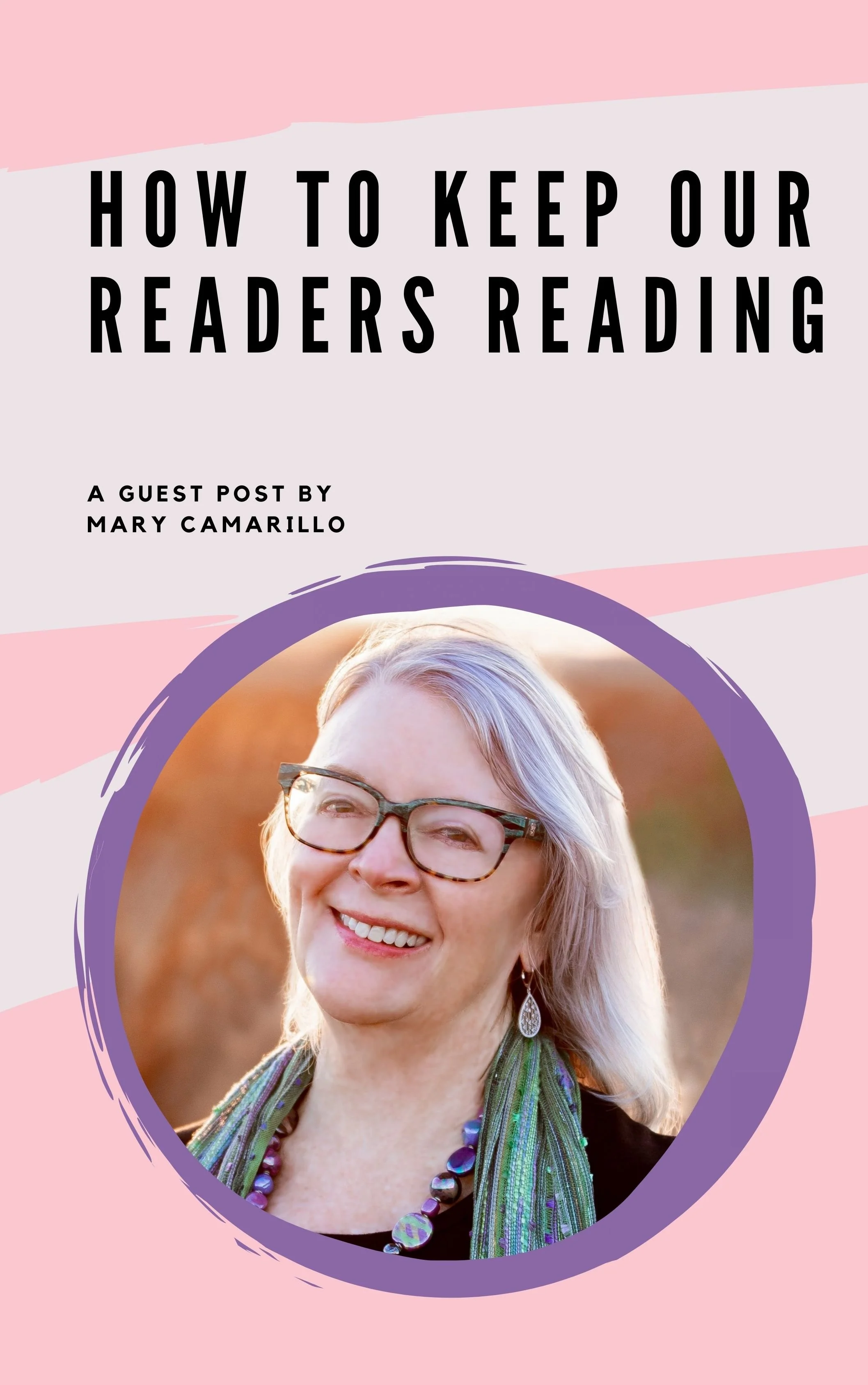How to Keep Our Readers Reading: A Guest Post by Mary Camarillo
I’m on maternity leave! During this time, a few of my favorite authors offered to step up and write guest posts so that this blog would remain active while I adjust to my new role as a mother. I may also be a bit slower to respond. Thanks for understanding and for being so supportive of me, my family, and my blog. Want to donate a few dollars to keep this blog running or perhaps contribute to my diaper fund? You can do so on Venmo or Paypal.
How to Keep Our Readers Reading: A Guest Post by Mary Camarillo
In this world of short attention spans and infinite distractions, what keeps a reader from setting a novel aside and checking Instagram, Hulu, or the latest baseball score instead? How do we write stories that are unputdownable? Here are twelve strategies to keep readers’ eyes on the page.
1. Start in the midst of action, with a character in chaos. This allows the reader to become immediately emotionally invested. For example, the television series CSI never begins with characters getting dressed for work. Instead, the camera zooms in on a dead body.
2. Authentic experience, based on reality, and told with honesty, compels the reader to keep their eyes on the page. What writers know about personally makes them unique and allows an authoritative voice. Novelist John Grisham uses his years of experience as an attorney to write legal thrillers, twenty-eight consecutive number-one fiction bestsellers at last count.
3. Specific details create a believable world. Describing a character’s physical characteristics, speech patterns, the clothing they wear, what they talk about, how they react to the weather, the music they hear on the radio, and what they see around them, encourages reader investment.
4. Complications keep the reader reading. Put your characters in predicaments, watch them struggle to work their way out, and have them make decisions they’ll regret. If characters feel conflicted about who they are and what they want, the reader feels conflicted too and keeps reading to resolve their uncertainty.
5. Introduce a secret or a mystery in early pages but don’t explain everything immediately. In Susan Straight’s novel, Mecca,” the narrator admits early on that he’d killed and buried a man in a remote canyon. The reader learns some of the details in following chapters but the relationships between those involved in the murder isn’t revealed until almost the end. The tension of not knowing pulls the reader through the pages.
6. Start a ticking clock. Give the character a set amount of time to reach a goal or suffer serious consequences. In Cinderella, the protagonist needs to get back to her coach before midnight or else it will turn into a pumpkin, and she won’t be home in time to meet her prince.
7. Surround the story with a secondary story. Shakespeare used this method frequently to give the outer story greater meaning and context. This “play within a play” tactic encourages the reader to keep reading to figure out how the inner and outer stories relate.
8. Bookend a story with a narrator in a future time period. This strategy is often used in television and movies to add meaning and context. In the TV Show This Is Us we see the Pearson family evolve over decades. In the movie Titanic we meet Rose at an advanced age. Even though we’re aware that Rose and most of the Pearson family survives, we keep watching to learn how their journeys unfolded.
9. Scaffold the story around an historical event or give a main character a brush with a famous person. This adds realism to the story's time and place and readers will keep reading to have their own memories and knowledge about the real events validated or challenged. E.L. Doctorow wove historical characters such as Houdini and Henry Ford into the lives of his fictional characters in Ragtime. John Lennon mingles with fictional characters in Tom Barbash’s The Dakota Winters.
10. Cliff hangers keep the pages turning. Thriller author Dan Brown of Da Vinci Code fame uses this device frequently. Something unexpected happens at the end of a chapter -- a strange character reveals himself, a ghastly truth is revealed, there’s a dead body -- but the events in the next chapter are about something else entirely. This forces the reader to keep reading to find out what happened.
11. Short chapters keep eyes on the page by creating a rapid pace. Giving the reader a place to pause also has the interesting effect of convincing the reader to finish “just one more chapter.” Many of the final chapters of Tommy Orange’s novel There There are only half a page, producing an almost strobe-like effect. James Patterson is a fan of short chapters and Margaret Atwood uses them in The Handmaid’s Tale.
12. Present tense gives a sense of urgency and adds a cinematic quality. T. Jefferson Parker wrote his latest novel A Thousand Steps in present tense. Other examples are Hunger Games, by Suzanne Collins, Cloud Cuckoo Land, by Anthony Doerr, and Bleak House, by Charles Dickens.
Of course, these strategies won’t work for every writer or reader. Cliff hangers can leave a reader feeling manipulated. Present tense can seem surfacy. A quick pace doesn’t give the reader much time to examine or contemplate. Some readers don’t enjoy a breakneck speed. Some readers prefer to amble along, waiting to be invited in. But if you can get your readers emotionally invested immediately, write in an authoritative voice, and create a complicated yet believable world, they won’t be able to put your work down.
Mary Camarillo’s debut novel The Lockhart Women, published in June of 2021 by She Writes Press, was a finalist in the 2022 WILLA Literary Fiction contest and took first place for First Fiction in the 2021 Next Generation Indie Awards. The novel is a mother/daughter/sister story about a divorce. It’s scaffolded around the O.J. Simpson murder trial because the main character needed something to obsess over instead of her ruined life. Camarillo is particularly proud of the cover endorsement by award winning author Eduardo Santiago which reads, “Unputdownable.”
How to Keep Our Readers Reading: A Guest Post by Mary Camarillo





